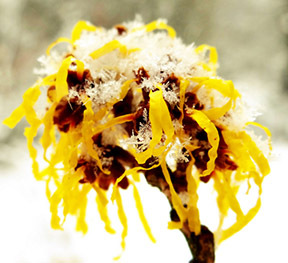Witch Hazel : Witch Hazel at UVM

A variety of the witch hazel species blooming under
a cover of snow in the Netherlands (Rooijen, 2013)
UVM’s campus is home to over 2500 trees. Unfortunately, witch hazel is not one of them, though it is native to Vermont. As a certified Tree Campus USA, inside of Burlington, VT which is designated as a Tree City, I believe it is important that we have representatives of all of Vermont’s native species on campus. Witch hazel is “perhaps one of New England’s most overlooked ornamental plants”(Connor, 1994, p. 177). A witch hazel tree on campus would be beneficial because it extends the flowering season. When there is an overall absence of foliage, witch hazel is coming into its flowering period. Having a late bloom on campus would add another color to campus that would contrast the empty limbed deciduous trees and dark evergreens.
Witch hazel can tolerate pollution and poor soil conditions, which means it is hardy enough to proliferate on UVM’s rural campus. Witch hazel has many cultivars which is why it is found across continents. Common cultivars include H. vernalis and H. mollis, vernal and chinese witch hazel. These cultivars are valued for their variations in color: from yellow to orange to red petals and also their scent: H. mollis is noted as being the most fragrant cultivar. American witch hazel, the native cultivar, has a few varieties, including henryi, macrophylla, and parvifolia. H. virginiana is the cultivar used for medicinal purposes, so it would be most fitting to incorporate on campus, including the fact that it is the native species.
Witch hazel has value as an ornamental because of its late bloom and the services it provides to the existing ecosystems on and around UVM. The fruit can be eaten by native bird species and small mammals that may find themselves on the UVM campus. The aroma of the witch hazel tree would also draw students and anyone else nearby to take a look, or sniff. Its rich history would be a beneficial learning tool for those studying medicine, plants, and or even history itself.
